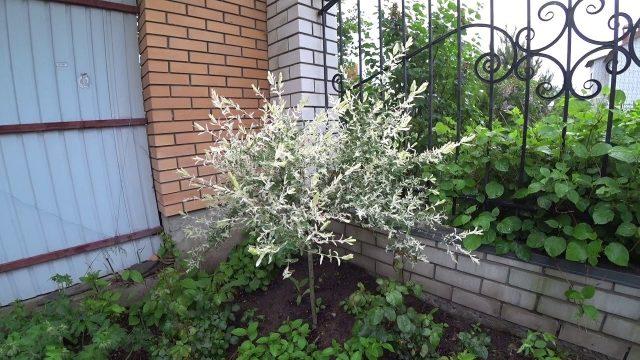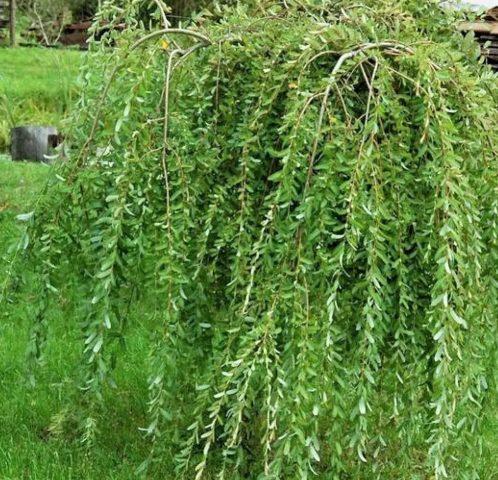Content
Willow on a trunk is an original decorative tree that can successfully fit into any landscape design. After all, it not only has an original appearance, but is also characterized by increased endurance and low maintenance requirements. You can purchase weeping willow seedlings in specialized nurseries, but the price is quite high. Therefore, many gardeners prefer to form their own planting material. But for this you need to know which varieties are suitable, and also take into account the peculiarities of the growing process.

Willow on a trunk can be of different heights
Features of standard willow
This form of tree is distinguished by the fact that it has one even trunk, at the top of which there is a lush, dense crown. It is possible to form a standard willow, as in the photo, only artificially, by removing excess side branches during its growth or by grafting into the upper part of the conductor.
Subsequently, regular pruning is required to maintain the high decorative value of the tree. The height of a willow on a trunk can be from 1 to 5 m, but most often it is 1.5-2.5 m. The main advantage of this form is that it looks elegant at any time of the year.
Other advantages of willow on a trunk:
- saving space on the site;
- simple processing of the peri-trunk space;
- easy tree care.
Types and varieties of willows for standard
In nature, there are about 170 types of crops and many varieties that were bred on their basis. But only some of them are suitable for forming a willow tree on a trunk. This is explained by their accelerated growth rate, as well as their high decorative value.
The best types and varieties of willow on a trunk:
- Pendula whole leaf (Pendula). This variety has increased winter hardiness and also withstands cold gusts of wind well. When using it, you get a weeping willow on a trunk with a lush flowing crown. The leaves are up to 15 cm long. The young plates are pinkish in color, but then quickly turn green, and in the fall they acquire a yellow tint. The whole-leaved willow variety Pendula tolerates drought well, but is demanding of light. The annual growth is 20 cm.
The whole-leaved Pendula variety blooms in mid-spring
- Hakuro-Nishiki. This Japanese willow on a trunk is distinguished by vigorous, upward-growing shoots. It responds well to pruning and quickly grows a dense crown with a diameter of about 3 m. The young leaves of Hakuro-Nishiki are pink in color, and then acquire a white-green color. The plates are narrow, graceful, 10 cm long, with sharp tips.
Hakuro-Nishiki goes well with monochromatic plants
- Nana. A distinctive feature of the purple willow variety is its thin, erect shoots, which bend closer to the tips under the weight of the foliage. The diameter of the tree crown on a trunk does not exceed 2 m. The annual growth is about 20 cm.The leaves are located oppositely on the shoots, 8 cm long. Flowering occurs at the end of April.
Purple willow Nana easily adapts to any climate
- Pendula goat. The variety is characterized by branched, flowing shoots, on which rounded-oblong leaves are densely located. It blooms at the end of April, at the beginning of May, the earrings are large, silvery. The leaves are matte, dark green on top and grayish on the back. This variety is the most common in ornamental gardening. By autumn, its leaves acquire a golden color.
The goat variety Pendula looks good in single and group plantings
- Curly Locks. You can grow willow on a trunk using this variety. Its winding shoots, falling to the ground, look original at any time of the year. Willow Curly Locks does not respond well to drafts, but can grow in partial shade. The leaves are small, bright green, turning yellow in autumn.
The Curly Locks variety is recommended to be planted near fences and buildings
How to make a willow tree with your own hands
Making a standard willow with your own hands is quite possible even for a novice gardener, if you strictly follow all the recommendations. You should not neglect even the simplest rules, otherwise the end result will be radically different from what was expected.
Selection of seedlings
To form a willow on a trunk, it is necessary to select seedlings with an even, smooth trunk. They should have a well-developed root system and no signs of disease. One-year-old seedlings take root most quickly, as they quickly adapt to a new place.
When purchasing, it is recommended to give preference to willows with a closed root system.This is due to the fact that the culture reacts poorly to drying out of the underground part.
Landing Features
For willow on a trunk, you need to choose a sunny, open place, protected from cold gusts of wind. But it is also possible to grow some varieties of crops in partial shade. Planting can be carried out throughout the season if conditions are favorable.
The best option for willow is loam, and the close occurrence of groundwater in the area is acceptable.
Two weeks before planting, you need to prepare a hole measuring 50 by 50 cm. It must be filled with turf, peat and humus in equal quantities. It is also recommended to add 40 g of superphosphate and 25 g of potassium sulfide, and then thoroughly mix the fertilizers with the soil. Planting a seedling should be carried out in a standard manner. Upon completion, the root collar should be level with the soil. Also, after the procedure, the seedling for the standard needs to be watered abundantly, and the next day the root circle should be mulched with peat.

After planting the willow on a trunk, it is recommended to tie it to a support
How to care
To form a willow tree as a standard, it is necessary to prune or graft correctly. Each gardener decides which method to choose for himself, based on knowledge and personal experience.
Watering
In the first 2-3 years after planting, it is recommended to organize proper watering of the tree, which will allow it to fully develop. This crop belongs to the moisture-loving category, and it does not respond well to drought. Therefore, in the absence of rain for a long time, it is recommended to moisten it regularly at the rate of 1-2 times a week. Watering is carried out at the root using settled water at a temperature of +18-20 °C.
The day after watering, it is recommended to loosen the soil at the base to maintain air access to the roots. If you follow this watering regime, after 2-3 years the tree will be ready to form a lush crown.
How to prune a willow tree
Pruning is the main procedure that will allow you to make a standard. It should be done after the tree has flowered. To do this, you need to determine for yourself the height of the trunk and completely remove all the side branches up to this mark. Then it is recommended to pinch the top and trim all other shoots to a length of 10-15 cm. In this case, it is important to shorten the bud pointing upward from the outside. Subsequently, the shoot grown from it will look beautiful.
Further, it is recommended to carry out several prunings per season. In this case, you need to shorten new branches according to the same principle. This will allow the correct shape of the crown to be formed on the trunk within several years. In the future, pruning must be carried out to maintain decorativeness.
You can also grow a tree of this shape if you graft a willow onto a trunk with your own hands. This method requires some skill, so it is recommended to first practice on other plants. However, it allows you to form the crown of a tree in the fastest possible time. However, for the idea to be successful, you need to follow the technology of grafting willow onto a standard and act according to the instructions.
Procedure:
- In April, select a willow cutting with 3-4 buds, the thickness of which will correspond to the diameter of the rootstock.
- Trim the top of the trunk straight.
- Make a wedge 2-3 cm long at the bottom of the cutting.
- From above, cut the scion obliquely under the upper bud.
- Make a longitudinal cut in the center of the stem.
- Insert the wedge of the handle into it and secure the junction tightly with polyethylene tape.
- Cover the damaged areas with garden varnish.
Willow on a trunk in landscape design
This ornamental tree looks good as a tapeworm and in group plantings. Willow on a trunk can be planted in a rock garden, a Japanese garden, or near a pond.

The culture looks impressive with low-growing plants

Willow on a trunk can grow in a row at a distance of 3 m

The plant retains its originality even against the background of a green lawn.

A blooming fountain will not leave anyone indifferent
Conclusion
Willow on a trunk is a plant that can be used to decorate even a small area. After all, the tree does not require much space, gets along well with other garden crops and is pleasing to the eye at any time of the year. You can grow willow on a trunk yourself. Even if the gardener has not yet mastered grafting, the crown can be formed by pruning. You just need to follow simple rules.













